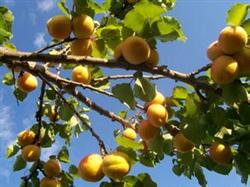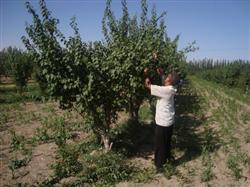Seedling raising technique of apricot
In recent years, as the market of bulk fruits such as apples and pears tends to be saturated, the market potential of miscellaneous fruits is great, especially the prospect of fresh apricots and kernel apricots is promising. Apricot is deeply loved by fruit growers because of its strong adaptability, easy cultivation, low investment and quick effect. Seedlings are mostly bred in rural areas, and their offspring vary greatly, so it is difficult to maintain the good characters of the original species. In this paper, the author's experience in cultivating apricot grafted seedlings in recent years is introduced, which can be used as a reference for fruit farmers. First, rootstock breeding apricot seedlings breeding rootstocks can use co-rootstocks or different rootstocks. Common rootstock has common apricot, mountain apricot; different rootstock has mountain peach, mountain plum and so on. But mainly mountain apricot. Rootstock seeds must be fully mature and stored in a dry place to prevent mildew. Sowing can be divided into autumn sowing or spring sowing. 1. Autumn sowing. It should be done before the soil is frozen. First of all, the nursery land is fully applied organic fertilizer, fine soil preparation. Then soak the seeds in 50 ℃ warm water for one day and night, or sow the seeds directly without treatment. The total seed amount of rootstock is 50-70 kg per 667 square meters and 40-50 kg of different rootstock. When sowing, you can sow with a single row or a wide and narrow row, with a single row spacing of about 40 cm, a wide row of 50 cm and a narrow row of 30 cm. Cover the soil about 8 cm after sowing, and finally pour enough winter water. two。 Spring sowing. As the seed shell of the rootstock is hard and not easy to break, it needs to be treated before sowing. ① sand hiding. The seeds were treated with sand before the beginning of winter. Select a shady and high dry place, dig a pit with a depth of 60 cm, a width of 1 m and a length determined by the amount of seeds. Spread a layer of sand 15 cm thick at the bottom of the pit, then mix 1 part of the seed and 2 parts of wet sand evenly, and put it into the pit for sand storage. The upper part of the pit is covered with 20 centimeters of wet sand, and the soil is steamed bread-shaped above the ground, with a thickness of 10 to 20 centimeters. The seed shell of mountain apricot is thick, and the sand storage time is generally more than 3 months. The earlier the sand is stored, the more seeds will naturally break the following year. Seeds were soaked in ②. During spring sowing, the stored seeds can be soaked, packed in plastic bags, exposed directly to the sun, sprinkled and stirred every 2-3 days, and then sowed after 15 days of seed cracking. The shell of ③ is broken artificially. If the amount of seed is small, the shell can be artificially broken before spring and soaked in warm water to accelerate budding after sowing. Sow seeds on ④. The seeds treated by the above methods were taken out and sown from late March to early April, and the nursery was irrigated once before sowing. After water infiltration, sufficient base fertilizer was applied, and ditches were prepared for sowing. Second, seedling grafting 1. Variety selection. New Century, Hongfeng, Zaohong, Hongguang, Golden Sun, Zhongmi No.1, Hongguan medium. If branch grafting or wood bud grafting needs to be cut off the scion the previous year and stored in sand after grafting in spring, it can be used when grafting; when budding, it can be cut directly from the mother tree. two。 Grafting method. ① budding in summer. In the middle and last ten days of July, when the thickness of the rootstock reached the thickness of chopsticks, T-shaped bud grafting was used. Apricot sprouts are soft and should be inserted slowly to prevent them from wrinkling and affecting their survival. Attention should also be paid to bud grafting in sunny days, and the wound is easy to flow glue in cloudy and rainy days to reduce the survival rate. ② was grafted in spring. Spring grafting can be carried out during the flow of sap in the following year, such as split grafting, subcutaneous grafting, woody bud grafting, single bud grafting and so on. According to several years of experiments, because of the large wound, the survival rate of split grafting is not as high as that of other methods. After grafting, the survival rate was higher with plastic film than with plastic strip. 3. Management of grafted seedlings the grafted seedlings should cut the rootstock in time after the sap flows in the following spring, and on the basis of strengthening fertilizer and water management and weeding, they should often wipe buds and remove sprouting, so that root nutrients can be concentrated to supply scions or new shoots from scions. When the seedling grows to 30 cm, tie up the pillar in time, and release the bandaged plastic film according to the growth condition to prevent the wind from breaking or breaking the seedling.
- Prev

The secret of increasing production of apricot trees
"Yunda Quan Fruit" is a new special growth aid for the balance of vegetative growth to reproductive growth on fruit trees and fruit vegetables (such as tomatoes, eggplants, melons, etc.). Its main features are: ① non-toxic performance, so that the fruit does not leave any residual poison, to achieve pollution-free, become a green rest assured product. ② promotes flowers quickly and quickly.
- Next

Five key points in the management of apricot trees after unloading fruit
First, thinning branches to remove the new apricot heads sprouting from the overdense perennial branches and backbone branches. Branches are evacuated and red apricots are full; branches are crowded and hanging is empty. Therefore, those who are in the wrong position and do not plan to be reserved for use as regeneration branches should be removed as soon as possible. Second, to pick the heart is to cut off the buds at the top of the apricot head. Usually take it off.
Related
- Moge, come on! The staff of the peasant association in the producing area of cantaloupe were frightened when the crowd gathered.
- Causes and Solutions of low Fruit setting rate of Apple
- Symptoms and control measures of passion fruit virus disease
- Fruit growing lesson: how do apple orchards keep high yields?
- Can you build orchards in the mountains? What are the pros and cons?
- How to manage the coloring period of Crisson grape?
- This paper introduces the processing technology of two kinds of fig products.
- How much is a month for retired teachers in rural areas by 2020?
- How can strawberry planting increase sugar content? We should pay attention to management in many aspects.
- What are the cultivation techniques on how to improve the yield of golden fruit?

